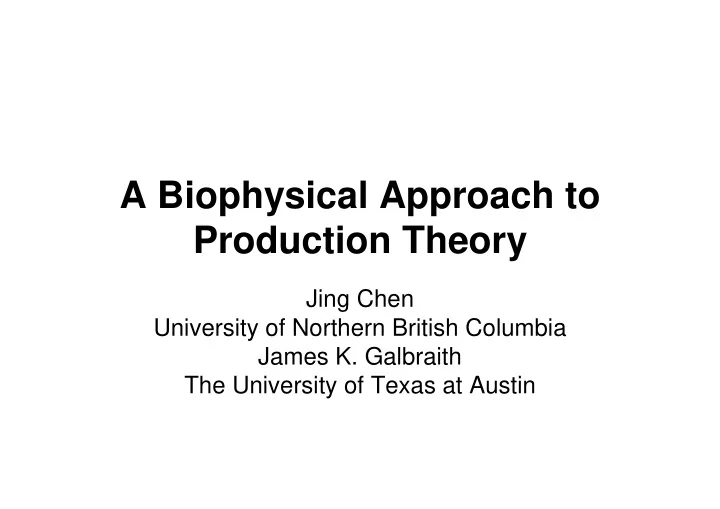

A Biophysical Approach to Production Theory Jing Chen University of Northern British Columbia James K. Galbraith The University of Texas at Austin
• Problems of the mainstream economic theory • Possibility for a new theory that is both relevant and analytical tractable? • Reflection on the past: – Astronomy before and after the establishment of modern astronomy
Main factors in economic activities • Fixed cost • Variable cost • Discount rate • Uncertainty • Duration of projects • Market size or output capacity
• With so many factors, is it possible to build up a simple analytical theory? • Instead of revising established frameworks, we ask: – What are the most fundamental properties of life?
Most fundamental properties of life • First, all systems, living or not, follow physical laws • Second, for an organism or organization to be viable, its cost in extracting resources from the environment has to be lower than the value of the resources obtained.
The analytical theory of production • Living systems need to extract low entropy from the environment to compensate for continuous dissipation. It can be represented mathematically by lognormal processes • dS rdt dz . S
From stochastic process to deterministic equation • Most values we observe or sense are the averages of random movements • Temperature vs. Velocity of individual molecules • Stock price vs. widespread opinions of different investors
The equation • If the discount rate of a system is r , from Feynman-Kac formula, any function of S , including the variable cost, C , satisfies the following equation 2 C C 1 C 2 2 rS S rC 2 t S 2 S
A short note on Feynman-Kac • Feynman developed the path integral approach in quantum mechanics. It integrated over probability distributions to obtain deterministic final results that are the observable quantities. • Kac refined it into a precise mathematical formula
The initial condition and the solution • C ( S , 0 ) max( S K , 0 ) • where S is the value of the commodity and K is the fixed cost. • When the duration is T , the solution rT C SN ( d ) Ke N ( d ) 1 2
A note about the formula • It takes the same form as the Black- Scholes formula for call option • Our theory was inspired by the Black- Scholes option theory • Technical details can be found from the paper
Some general properties • Higher fixed costs, lower variable costs • Longer the duration of a project, higher variable cost • Uncertainty increases, variable cost increases. • Discount rate increases, variable cost increases • Fixed cost approaches zero, variable cost approaches to the value of the product. • Variable cost is lower than the value of product. • All these properties are consistent with our intuitive understanding of production processes.
Fixed cost, variable cost, volume of output and return • Suppose the volume of output is Q, which is bound by production capacity or market size. Then the total value of the products and the total cost of production are • SQ and C ( K , ) Q K . • respectively. The return that this producer earns is SQ ln( ) • C ( K , ) Q K
Output and return with different levels of fixed costs 0.5 0.4 0.3 0.2 0.1 Low fixed cost 0 High fixed cost 1 2 3 4 5 6 7 8 9 10 11 12 -0.1 -0.2 -0.3 -0.4 -0.5 Output
Properties of this theory • Path dependant – The structure and amount of fixed cost affect future development • Increasing returns and critical mass – higher fixed cost investments, which have lower variable costs in production, have higher output volume to breakeven • Non-equilibrium theory
Discussion • the type and level of fixed investment depends on the expectation of the level of uncertainty of production technology and the size of the market. • These expectations may or may not materialize.
Uncertainty and variable cost 1.2 1 Variable cost 0.8 High volatility 0.6 Low volatility 0.4 0.2 0 1 2 3 4 5 6 7 8 9 10 11 12 13 Level of fixed cost
Uncertainty and variable cost • As fixed costs are increased, variable costs, decrease rapidly in a low uncertainty environment and decreases slowly in a high uncertainty environment. • High fixed cost systems, which are often regarded as superior systems, do not necessarily provide higher returns
Fixed cost and duration of the project 4 3 2 1 Return 0 One long project 1 2 3 4 5 6 7 8 9 10 Two short Porhject -1 -2 -3 -4 -5 Duration
• It explains why individual life does not go on forever. It is more profitable for animals, including human beings, to produce offspring instead of prolong life indefinitely.
• The relations among discount rate, fixed cost, duration of project and market size • Low discount rate, amount of mortgage lending, inflation and current financial crisis
Concluding remarks • It is often suggested that economic theories, for analytical ease and tractability, sacrifice their relevance to reality • This theory shows that an economic theory based on the firm foundation of reality is actually simpler analytically. – Human mind is evolved to understand important problems as simple as possible. • This production theory is part of a general economic theory
Recommend
More recommend